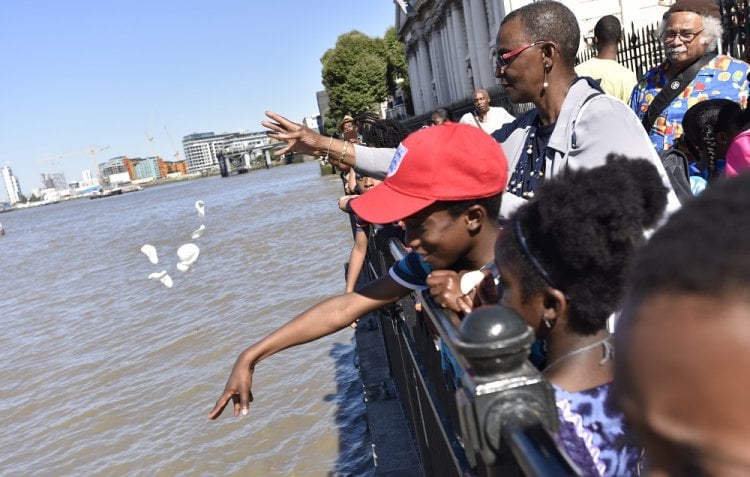
Visitors celebrating International Slavery Remembrance Day
Photo: National Maritime Museum, London
Our horrible histories
Should museums shy away from talking about torture, sexuality and death with children? Sacha Coward explains why he thinks no topic should be off limits.
A lot of the stories that our collections at the National Maritime Museum in Greenwich tell are very dark. There are numerous objects related to death and violence in wartime, such as cat-o-nine tails and surgical saws, fist-sized chunks of shrapnel from the Battle of Jutland and the jacket that Nelson died in. Our display about the Transatlantic slave trade, one of the most shockingly long-term human atrocities, includes restraining irons, instruments of torture and lists that log human lives as mere chattel.
Anyone who has watched a child in a museum can see that they are immediately attracted to blood and gore
Considering the harshness of these narratives, it might be tempting to censor or hide them from our young visitors for fear of upsetting them. But I would argue that for any museum, archive or historical site to dilute its dark, dangerous and controversial stories would actually be a terrible disservice to young audiences.
International Slavery Remembrance Day
As an example of how children can engage with a seemingly inaccessible ‘adult only’ topic, look to the International Day for the Remembrance of the Slave Trade and its Abolition. Every year on 23 August, UNESCO marks the anniversary of the Haitian uprising that eventually led to the abolition of slavery and, together with the International Slavery Museum in Liverpool, we host a day of commemoration.
Both sites are full of activities and workshops for children and families that explore this history in an appropriate and nuanced way, often looking at African culture pre- and post-slavery to give a context for young people. Through music, object-handling, storytelling and dance, the events are an opportunity for families to connect with this difficult history in a safe space.
Recognising inequalities
Only in the past few years has the museums sector as a whole started to embrace this social justice model for talking about collections and even supporting activism within communities. Museums are beginning to use their beautiful buildings and lovely objects to reflect on modern-day inequalities and their own outdated representations of race, gender, sexuality, disability and other underserved audiences.
It is incredibly exciting to see so many projects beginning to explore gender and sexual identity in human history. Although children have very rarely been a target audience for these kinds of projects and there is an unspoken sense that it may be too dangerous or inappropriate to have these conversations with young people.
There is a fear that it might confuse them and that they might not be capable of understanding these complex ideas. Yet at the age of three, children are already learning about fairness, sharing and justice, and these are the grounding principles for understanding inequality.
To engage with challenging topics and to truly legitimise diverse perspectives, children need to be part of these conversations at an early age.
Our ‘Out At Sea’ Family Festival event celebrates gender and sexual diversity. The activities range from meeting a cross-dressing pirate to learning about colour and symbolism in the rainbow flag. It is both possible and important to talk about complex concepts, such as sexual identity, with children in an age-appropriate and engaging way. All it takes is to reflect on what the target age group already knows and comprehends, then build on this.
Facing up to death
We need to start giving children more credit. The Horrible Histories series by Terry Deary has been around since I was a child and remains popular today, mainly because it leaves the nasty stuff in. Anyone who has watched a child in a museum can see that they are immediately attracted to blood and gore. Simply put, children have a much more developed concept of so-called ‘adult concepts’ than we might expect.
Even death, one of our most feared topics, is understood by young children. Most four-year-olds understand the idea of the finality of death. In 2016 the Bristol Museum and Art Gallery ran an exhibition entitled ‘Death: The Human Experience’. As part of this they celebrated the Mexican ‘Day of the Dead’ festival with families and children.
The fact that they set out to treat death as a human experience and allowed children to form positive, playful and happy associations is incredibly powerful in terms of future health and wellbeing.
A moral imperative
While it is important for museums to think carefully about how they engage with audiences of different ages and the sensitivities that all young visitors might bring with them, all museums have a moral imperative to share their collections openly with children.
I believe that young people can only learn about the inequalities and dangers that exist in society today by reflecting and engaging with lessons from the past. By scaffolding activities, workshops and galleries around childhood developmental and cognitive milestones, dangerous stories can be vital tools to growing minds. They can help them understand society and look out for future warning signs and dangerous trends.
Museums are a fantastic space to begin talking about difficult issues today, issues that almost all children will need to address as they grow up. Mental health, sexuality, gender roles and class are repeated themes throughout history. By drawing them out for younger audiences the aim is not to frighten them, but to arm them with a deeper understanding of the rich and complex world they live in.
Sacha Coward is Community Participation Producer at National Maritime Museum.
www.rmg.co.uk/national-maritime-museum
Join the Discussion
You must be logged in to post a comment.